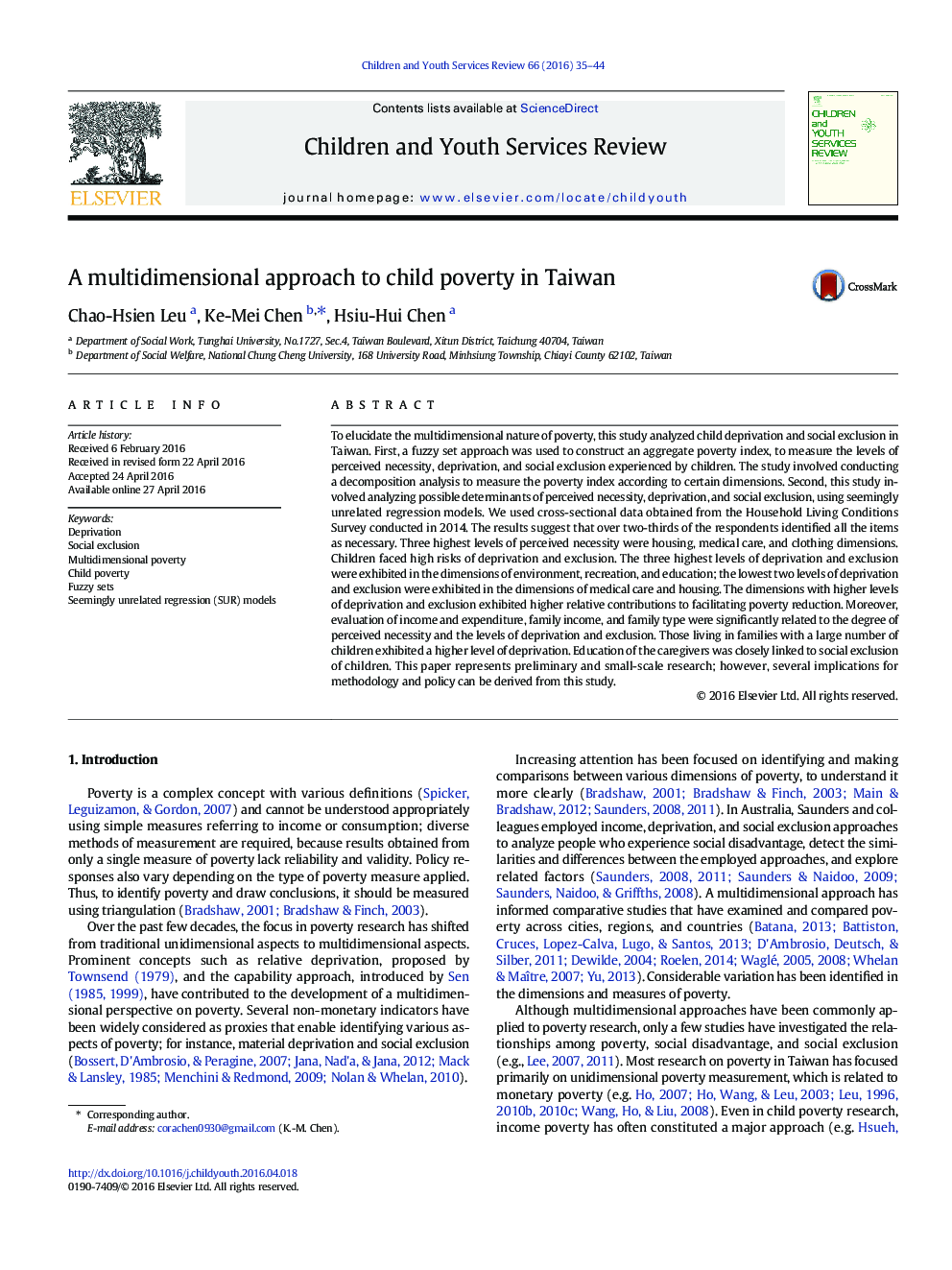| کد مقاله | کد نشریه | سال انتشار | مقاله انگلیسی | نسخه تمام متن |
|---|---|---|---|---|
| 6833776 | 617767 | 2016 | 10 صفحه PDF | دانلود رایگان |
عنوان انگلیسی مقاله ISI
A multidimensional approach to child poverty in Taiwan
ترجمه فارسی عنوان
یک رویکرد چند بعدی برای فقر کودکان در تایوان
دانلود مقاله + سفارش ترجمه
دانلود مقاله ISI انگلیسی
رایگان برای ایرانیان
کلمات کلیدی
ترجمه چکیده
این تحقیق به بررسی ماهیت چند بعدی فقر، محرومیت ازدواج و جدایی اجتماعی در تایوان را مورد بررسی قرار داد. ابتدا یک رویکرد فازی برای ساختن شاخص کل فقر، برای اندازه گیری سطح ضرورت درک، محرومیت و محرومیت اجتماعی که توسط کودکان مورد استفاده قرار می گرفت، مورد استفاده قرار گرفت. این مطالعه شامل انجام تجزیه و تحلیل تجزیه و تحلیل برای اندازه گیری شاخص فقر با توجه به ابعاد خاص است. دوم، این مطالعه شامل تحلیل عوامل احتمالی ضرورت، محرومیت و انزوای اجتماعی با استفاده از مدل های رگرسیون ظاهرا غیر مرتبط است. ما از داده های مقطعی از وضعیت بررسی شرایط زندگی خانوار در سال 2014 استفاده کردیم. نتایج نشان می دهد که بیش از دو سوم از پاسخ دهندگان همه موارد را در صورت لزوم شناسایی کرده اند. سه سطح بالاتر از ضرورت درک شده مسکن، مراقبت های پزشکی و ابعاد لباس بود. کودکان با ریسک بالای محرومیت و محرومیت مواجه شدند. سه سطح بالاتر محرومیت و محرومیت در ابعاد محیطی، تفریحی و آموزشی نمایش داده شد. کمترین دو سطح محرومیت و محرومیت در ابعاد مراقبت های پزشکی و مسکن نمایش داده شد. ابعاد با سطوح بالاتری از محرومیت و محرومیت، سهم نسبی بیشتری را در تسهیل کاهش فقر نشان دادند. علاوه بر این، ارزیابی درآمد و هزینه، درآمد خانواده و نوع خانواده به طور معنی داری به میزان ضرورت درک شده و میزان محرومیت و محرومیت مربوط می شود. کسانی که در خانواده هایی با تعداد زیادی از کودکان زندگی می کنند، میزان محرومیت بیشتری را نشان می دهند. آموزش و پرورش مراقبان به طور جدی با جدایی اجتماعی کودکان ارتباط داشت. این مقاله نشان دهنده تحقیقات اولیه و کوچک است؛ با این حال، چندین دلیل برای روش شناسی و سیاست میتواند از این مطالعه حاصل شود.
موضوعات مرتبط
علوم پزشکی و سلامت
پزشکی و دندانپزشکی
پریناتولوژی (پزشکی مادر و جنین)، طب اطفال و بهداشت کودک
چکیده انگلیسی
To elucidate the multidimensional nature of poverty, this study analyzed child deprivation and social exclusion in Taiwan. First, a fuzzy set approach was used to construct an aggregate poverty index, to measure the levels of perceived necessity, deprivation, and social exclusion experienced by children. The study involved conducting a decomposition analysis to measure the poverty index according to certain dimensions. Second, this study involved analyzing possible determinants of perceived necessity, deprivation, and social exclusion, using seemingly unrelated regression models. We used cross-sectional data obtained from the Household Living Conditions Survey conducted in 2014. The results suggest that over two-thirds of the respondents identified all the items as necessary. Three highest levels of perceived necessity were housing, medical care, and clothing dimensions. Children faced high risks of deprivation and exclusion. The three highest levels of deprivation and exclusion were exhibited in the dimensions of environment, recreation, and education; the lowest two levels of deprivation and exclusion were exhibited in the dimensions of medical care and housing. The dimensions with higher levels of deprivation and exclusion exhibited higher relative contributions to facilitating poverty reduction. Moreover, evaluation of income and expenditure, family income, and family type were significantly related to the degree of perceived necessity and the levels of deprivation and exclusion. Those living in families with a large number of children exhibited a higher level of deprivation. Education of the caregivers was closely linked to social exclusion of children. This paper represents preliminary and small-scale research; however, several implications for methodology and policy can be derived from this study.
ناشر
Database: Elsevier - ScienceDirect (ساینس دایرکت)
Journal: Children and Youth Services Review - Volume 66, July 2016, Pages 35-44
Journal: Children and Youth Services Review - Volume 66, July 2016, Pages 35-44
نویسندگان
Chao-Hsien Leu, Ke-Mei Chen, Hsiu-Hui Chen,
